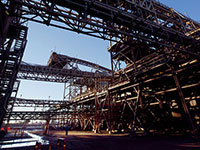IRON ORE

The iron ore deposits are contained within a sequence of early Proterozoic sediments of the Transvaal Supergroup deposited between 2,500 and 2,200 million years ago. In general, two types of ore are present, namely the laminated hematite ore, which forms part of the Manganore iron formation, and the conglomerate ore, which belongs to the Doornfontein Conglomerate Member at the base of the Gamagara Formation.
The older laminated ore types occur in the upper portion of the Manganore Iron Formation as enriched high-grade hematite bodies. The boundaries of these ore bodies crosscut primary sedimentary bedding, indicating that secondary hematisation of the iron formation took place. In all of these formations, some of the stratisgraphic and sedimentological features of the original iron formation are preserved.
The conglomeratic ore is found in the Doornfontein Conglomerate Member of the Gamagara Formation and is lenticular and not persistently developed along strike. It consists of stacked, upward fining conglomerate-grit stone shale sedimentary cycles. The lowest conglomerates and grit stones tend to be rich in sub rounded to rounded hematite ore pebbles and granules and form the main ore bodies. The amount of iron ore pebbles decreases upwards in the sequence so that upper conglomerates normally consist of poorly sorted, angular to rounded chert and banded iron formation pebbles.
Erosion of the northern Khumani deposit is less than that of the southern Beeshoek area. This results in Khumani being characterized by larger stratiform bodies and prominent hanging wall outcrops. The downward-dip portions are well preserved and developed, but in the outcrops, the deposits are thin and isolated. Numerous deeper extensions occur into the basins due to karst development.
A prominent north-south strike of the ore is visible. The southern Beeshoek ore bodies are exposed to more erosion and are smaller and more localized. Outcrops are limited to the higher topography on the eastern side of the properties.
Looking at the downward-dip to the west, the ore is thin and deep. The strike of the ore bodies is also in a north-south direction, but less continuous. Hematite is the predominant ore mineral, but limonite and specularite also occur.